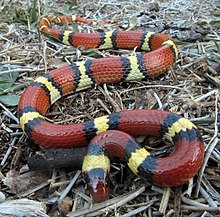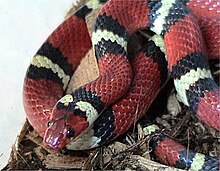Scarlet kingsnake
| Scarlet kingsnake | |
|---|---|

| |
| Adult Lampropeltis elapsoides in Florida | |
| Scientific classification | |
| Domain: | Eukaryota |
| Kingdom: | Animalia |
| Phylum: | Chordata |
| Class: | Reptilia |
| Order: | Squamata |
| Suborder: | Serpentes |
| Family: | Colubridae |
| Genus: | Lampropeltis |
| Species: | L. elapsoides
|
| Binomial name | |
| Lampropeltis elapsoides (Holbrook, 1838)
| |
| Synonyms | |
The scarlet kingsnake or scarlet milk snake (Lampropeltis elapsoides) is a species of kingsnake found in the southeastern and eastern portions of the United States.[4] Like all kingsnakes, they are nonvenomous. They are found in pine flatwoods,[5] hydric hammocks, pine savannas, mesic pine-oak forests, prairies, cultivated fields, and a variety of suburban habitats; not unusually, people find scarlet kingsnakes in their swimming pools, especially during the spring. Until recently, and for much of the 20th century, scarlet kingsnakes were considered a subspecies of the milk snake; however, Pyron and Bubrink[6] demonstrated the phylogenetic distinction of this species and its closer relationship to the mountain kingsnakes of the southwestern United States. These largely fossorial snakes are the smallest of all the species within the genus Lampropeltis, usually ranging from 40 to 50 cm (16 to 20 in) at maturity. The maximum recorded length is in Jonesboro, AR 76.2 cm (30.0 in). Hatchlings range in size from 8 to 18 cm (3.1 to 7.1 in). [7]
Taxonomy


The
The scarlet kingsnake was once believed to have
Description
This section includes a improve this section by introducing more precise citations. (May 2016) ) |

Scarlet kingsnakes have a tricolored pattern of black, red, white, and various shades of yellow bands that appear to
Scarlet kingsnakes are born with white, black, and red banding. As they mature, they develop varying shades of yellow within geographic areas where this is expressed. In addition, the yellowing is not uniform, but rather this pigmentation proceeds from lighter to darker from the lowermost scales upward to the dorsum, or "back", presenting a multiple yellowish band. Early expression of yellowing appears as early as 3 months and continues through the first 3 years. As adults age, a gradual darkening of the yellowish banding occurs. The yellow pigmentation varies from lemon, to school-bus yellow, to tangerine, to apricot. [citation needed]
Scarlet kingsnakes are secretive,
Hatchling scarlet kingsnakes show a strong predisposition for
Reproduction
The scarlet kingsnake is polygynandrous, meaning both males and females will mate with multiple partners.[15] Their breeding season is March-June, and females have multiple egg clutches that incubate for 40-65 days. [16]
Lampropeltis elapsoides is an oviparous species of snake that lays eggs in clutches of 4-12, usually under rotting wood and between rocks and logs. These eggs are white and slender, with most adhering to one another. Eggs typically hatch within 2-2.5 months, though times may vary.[17]
In other media
Film
Scarlet kingsnakes were used to simulate coral snakes in the 2006 film Snakes on a Plane.[18] A scarlet kingsnake also appears briefly as an unidentified venomous snake in an early scene of 2001 film The Mummy Returns.[19]
Television
In Season 5 of Peep Show Super Hans rents a scarlet kingsnake as a prop for a house party. Despite Hans' mnemonic stating "Red next to black, jump the fuck back, red next to yellow, cuddly fellow", kingsnakes are not venomous.
References
- . Retrieved 6 June 2022.
- Stejneger, Leonhard; Barbour, Thomas. 1917. A Check List of North American Amphibians and Reptiles. Cambridge, Massachusetts: Harvard University Press. 125 pp. (Lampropeltis elapsoides, p. 88).
- ^ The Reptile Database. www.reptile-database.org.
- ^ Willson, J (2023-10-19). "Scarlet Kingsnake / Eastern Milksnake (Lampropeltis triangulum)". Archived from the original on 2023-08-17.
- ^ JSTOR 1565915
- PMID 19236930, archived from the originalon 2011-10-06
- ^ " "Lakewood Ranch Snake Removal | Nuisance Wildlife Control and Removal Lakewood Ranch Snake Trapping | Lakewood Ranch Animal Control Trapping Removal Service | Attic Repair and Restoration in Lakewood Ranch | Wildlife Trapper".
- ISBN 978-1-4616-3564-2.
the smooth dorsal scales have an enamel-like surface to which the genus' Latin name, Lampropeltis, or "shining skin shield," refers.
- ^ "Virginia Herpetological Society". www.virginiaherpetologicalsociety.com. Retrieved 2023-10-19.
- ^ "Scarlet Kingsnake". a-z-animals. Retrieved June 10, 2023.
- ^ "Species Profile: Scarlet Kingsnake / Eastern Milksnake (Lampropeltis triangulatum) | SREL Herpetology". srelherp.uga.edu. Retrieved 2023-06-11.
- ^ "Species Profile: Eastern Coral Snake (Micrurus fulvius) | SREL Herpetology". srelherp.uga.edu. Retrieved 2023-06-11.
- ^ Williams, Kenneth L. (1988), Systematics and natural history of the American milk snake, Lampropeltis triangulum., Milwaukee, WI: Milwaukee Public Museum
- ISSN 2332-4961.
- ISSN 0022-1511.
- ^ Groves, J. D., & Sachs, P. S. (1973). Eggs and young of the scarlet king snake, Lampropeltis triangulum elapsoides. Journal of Herpetology, 7(4), 389. https://doi.org/10.2307/
- ^ "Virginia Herpetological Society". www.virginiaherpetologicalsociety.com. Retrieved 2023-06-11.
- ^ Case, Russ (2011-12-01). "Snakes On A Plane". Reptiles Magazine. Archived from the original on February 3, 2023. Retrieved 2023-06-10.
- ^ "The Mummy Returns (2001)". californiaherps.com. Retrieved 2023-06-10.
Further reading
- ISBN 0-395-19977-8(paperback). (Lampropeltis triangulum elapsoides, p. 209 + Plate 30 + Map 153.)
- Holbrook, John Edwards. 1936. North American Herpetology; or, A Description of the Reptiles Inhabiting the United States. Vol. II. Philadelphia: J. Dobson. 130 pp. + Plates I.- XXX. (Coluber elapsoides, pp. 123–125 + Plate XXVIII.)
- Schmidt, Karl P.; Davis, D. Dwight. 1941. Field Book of Snakes of the United States and Canada. New York: G.P. Putnam's Sons. 365 pp. (Lampropeltis elapsoides, p. 173 + Plate 6.)
- ISBN 0-307-13666-3. (Lampropeltis triangulum elapsoides, pp. 180–181.)
- Wright, Albert Hazen; Wright, Anna Allen. 1957. Handbook of Snakes of the United States and Canada. Ithaca and London: Comstock. 1,105 pp. (in two volumes) (Lampropeltis doliata doliata, pp. 351–355, Figure 106 + Map 31 on p. 338.)

